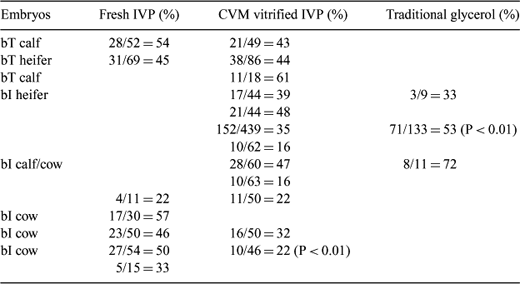243 PREGNANCY RATES IN THE FIELD AFTER THE TRANSFER OF BOVINE IVP EMBRYOS VITRIFIED BY THE CRYOLOGIC VITRIFICATION METHOD
R. Fry A , C. Earl A , K. Fry A and W. Lindemans BA Animal Reproduction Company, Werribee, Victoria 3030, Australia
B CryoLogic, Pty, Ltd., Mulgrave, Victoria 3170, Australia. Email: animalreproductionco@bigpond.com
Reproduction, Fertility and Development 17(2) 272-272 https://doi.org/10.1071/RDv17n2Ab243
Submitted: 1 August 2004 Accepted: 1 October 2004 Published: 1 January 2005
Abstract
Although large numbers of IVP embryos can be produced from donor cattle in a short period of time, commercial acceptance of the technology depends on the ability to cryopreserve these embryos and achieve a 50% pregnancy rate in large-scale embryo transfer programs. Many studies have reported low pregnancy rates of about 20% after the transfer of cryopreserved IVP embryos. We have developed the user friendly CryoLogic Vitrification Method (CVM) that vitrifies embryos on a solid surface at −196°C and warms them rapidly in a one-step procedure prior to transfer (Lindemans et al. 2004 Reprod. Fertil. Dev. 16, 174). We present an overview of the pregnancy rates in the field after vitrification of bovine IVP embryos by the CVM. The bos taurus IVP embryos in southern Australia (bT) and the bos indicus-based IVP embryos in northern Australia (bI) were produced by our standard TVR and IVP methodology (Fry et al., 2003 Theriogenology 59, 446). Pregnancy was determined by rectal palpation between Day 40 and Day 90 and differences between treatments were analyzed by chi-square. The development of the CVM has enabled the successful cryopreservation of bovine IVP embryos. In the laboratory the typical survival (90% re-expansion) and development (80% hatching) of IVP embryos post-vitrification is high and, as demonstrated here, the pregnancy rates after transfer are approaching commercially acceptable levels. However, further research is required to identify factors that may influence success under full field conditions, for both the IVP and the vitrification technologies.

|


